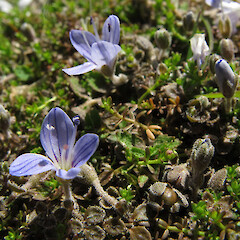Veronica lilliputiana
Common name
tarn speedwell, tarn parahebe
Synonyms
Veronica canescens Kirk, Hebe canescens (Kirk) A.Wall, Parahebe canescens (A.Wall) W.R.B.Oliv.
Family
Plantaginaceae
Flora category
Vascular – Native
Endemic taxon
Yes
Endemic genus
No
Endemic family
No
Structural class
Herbs - Dicotyledons other than Composites
NVS code
The National Vegetation Survey (NVS) Databank is a physical archive and electronic databank containing records of over 94,000 vegetation survey plots - including data from over 19,000 permanent plots. NVS maintains a standard set of species code abbreviations that correspond to standard scientific plant names from the Ngä Tipu o Aotearoa - New Zealand Plants database.
PARCAN
Chromosome number
2n = 42
Current conservation status
The conservation status of all known New Zealand vascular plant taxa at the rank of species and below were reassessed in 2017 using the New Zealand Threat Classification System (NZTCS) – more information about this can be found on the NZTCS website. This report includes a statistical summary and brief notes on changes since 2012 and replaces all previous NZTCS lists for vascular plants.
Please note, threat classifications are often suggested by authors when publications fall between NZTCS assessment periods – an interim threat classification status has not been assessed by the NZTCS panel.
- Conservation status of New Zealand indigenous vascular plants, 2017 . 2018. Peter J. de Lange, Jeremy R. Rolfe, John W. Barkla, Shannel P. Courtney, Paul D. Champion, Leon R. Perrie, Sarah M. Beadel, Kerry A. Ford, Ilse Breitwieser, Ines Schönberger, Rowan Hindmarsh-Walls, Peter B. Heenan and Kate Ladley. Department of Conservation. Source: NZTCS and licensed by DOC for reuse under the Creative Commons Attribution 4.0 International licence.
2017 | At Risk – Declining | Qualifiers: DP
Previous conservation statuses
2012 | At Risk – Declining | Qualifiers: DP
2009 | Not Threatened
2004 | Not Threatened
Distribution
Endemic. New Zealand: South Island from Canterbury to Fiordland. Recorded by Aston on the Otago Peninsula in 1896 and was rediscovered there in 2011.
Habitat
Coastal (Otago Peninsula) but otherwise confined to montane areas where it inhabits the margins of ephemeral pools tarns and lakes, usually in places that dry out in summer.
Wetland plant indicator status rating
Information derived from the revised national wetland plant list prepared to assist councils in delineating and monitoring wetlands (Clarkson et al., 2021 Manaaki Whenua – Landcare Research Contract Report LC3975 for Hawke’s Bay Regional Council). The national plant list categorises plants by the extent to which they are found in wetlands and not ‘drylands’. The indicator status ratings are OBL (obligate wetland), FACW (facultative wetland), FAC (facultative), FACU (facultative upland), and UPL (obligate upland). If you have suggestions for the Wetland Indicator Status Rating, please contact: [Enable JavaScript to view protected content]
FACW: Facultative Wetland
Usually is a hydrophyte but occasionally found in uplands (non-wetlands).
Detailed description
Short-lived creeping herb, 3-10 mm tall. Old stems brown or red-brown. Branches prostrate. Branchlets brown or green. Vegetative internodes 1-15 mm long. Stem pubescence uniform or absent, eglandular pubescent (short curved white hairs). Leaves spreading to recurved. Lamina ovate or obovate or elliptic or orbicular, 1-3 × 1-2 mm. Upper surface of leaves glaucous, dull. Under surface of leaves glaucous, dull. Leaf hairs eglandular, scattered, on all parts of leaf (most dense on midline and at apex). Apex obtuse to rounded. Base cuneate. Margin ciliate, entire. Petiole 0.0-0.5 mm long. Inflorescence 1-2-flowered, 3-12 mm long at fruiting. Indumentum of peduncle, rachis, and pedicels sparse. Eglandular hairs of inflorescence deflexed (and tangled), white. Peduncle 1-5 mm long, eglandular-pubescent. Bracts paired and opposite, obtuse to subacute, eglandular-hairy adaxially and eglandular-hairy abaxially, elliptic or ovate. Bract margins entire. Pedicels suberect at anthesis, straight at fruiting, 2-7 mm long, densely eglandular-pubescent. Flowers: Calyx 4-5-lobed, 2.0-3.5 mm long. Calyx lobes lanceolate to oblong, subacute to obtuse. Calyx hairs on under surface, eglandular. Calyx lobe margins entire. Corolla pale blue at anthesis (paler below). Nectar guides evident, present on all corolla lobes. Colour ring and nectar guides blue. Corolla throat same colour as lobes. Corolla c.10 mm diameter. Corolla tube 1 mm long, 1.0-1.5 mm wide, hairy inside, hairs short. Corolla lobes glabrous. Posterior corolla lobe elliptic, subacute to divided in two, 3-6 × 2-3 mm. Lateral corolla lobes elliptic, obtuse, flat, not enfolding stamens, 3.0-6.0 × 2.0-3.0 mm. Anterior corolla lobe narrowly elliptic, obtuse, 3.0-6.0 × 2.0-2.5 mm. Stamen filaments white, 4-5 mm long, weakly narrowed at base. Anthers mauve or violet, 0.7-1.5 mm long. Nectarial disc glabrous. Ovary ovoid, obtuse, glabrous, 0.8- 1.0 mm long. Style 4.0-5.5 mm long. Stigma 0.5 mm wide. Capsules narrowly angustiseptate emarginate, 1.0-1.5 × 1.0-2.0 mm, c.0.5 mm thick, glabrous. Septicidal split extending to base. Loculicidal extending ¾ way to base or to base. Seeds strongly flattened, smooth-surfaced, ellipsoid to obovoid, pale brown to brown, c.0.5 × c.0.3 mm.
Similar taxa
Easily recognised by the minute prostrate growth habit, fine, cotton thread-like, branches, entire leaves, which including the petiole, are 1.0-2.5–3.5 mm long; and by the flowers which have very short corolla tubes (<1 mm long) and blue corollas with darker nectar guides.
Flowering
October - January
Flower colours
Blue, Violet/Purple
Fruiting
November - April
Propagation technique
Easily grown from rooted pieces and bulbils but difficult to maintain. Best grown in a sunny situation, kept in a pot, partially submerged in water. Prone to powdery mildew in humid climates.
Etymology
veronica: Named after Saint Veronica, who gave Jesus her veil to wipe his brow as he carried the cross through Jerusalem, perhaps because the common name of this plant is ‘speedwell’. The name Veronica is often believed to derive from the Latin vera ‘truth’ and iconica ‘image’, but it is actually derived from the Macedonian name Berenice which means ‘bearer of victory’.
Attribution
Description adapted from Garnock-Jones and Lloyd (2003).
References and further reading
Garnock-Jones, P.J.; Lloyd, D.G. 2003: A taxonomic revision of Parahebe (Plantaginaceae) in New Zealand. New Zealand Journal of Botany 42: 181-232.










